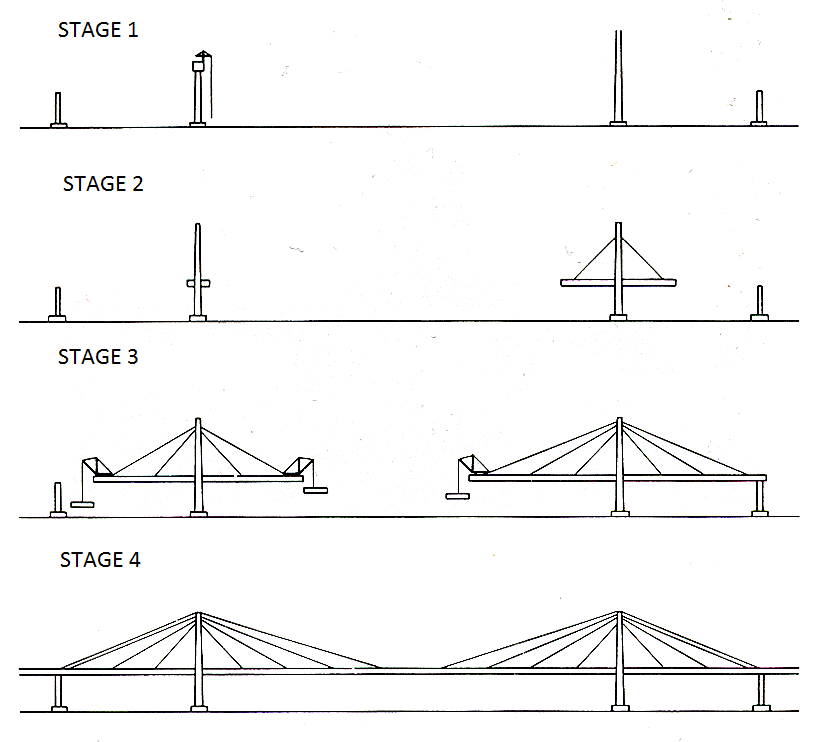Construction Sequence on Bridges
The towers
Tower foundations are prepared by digging down to a sufficiently firm rock formation. Some bridges are designed so that their towers are built on dry land, which makes construction easier.
If a tower will stand in water, its construction begins with lowering a caisson (a steel and concrete cylinder that acts as a circular dam) to the ground beneath the water; removing the water from the caisson's interior allows workers to excavate a foundation without actually working in water.
If the bedrock is too deep to be exposed by excavation or the sinking of a caisson, pilings are driven to the bedrock or into overlying hard soil, or a large concrete pad to distribute the weight over less resistant soil may be constructed, first preparing the surface with a bed of compacted gravel.
The piers are then extended above water level, where they are capped with pedestal bases for the towers. From where towers of single or multiple columns are erected using high-strength reinforced concrete, stonework, or steel. Concrete is used most frequently in modern suspension bridge construction due to the high cost of steel.
Saddles
Saddles are large devices, which will carry the main suspension cables, are positioned atop the towers. Typically of cast steel, they can also be manufactured using riveted forms, and are equipped with rollers to allow the main cables to shift under construction and normal loads.
Anchorages
They are the structures to which the ends of the bridge's cables are secured. They are massive concrete blocks securely attached to strong rock formations. During construction of the anchorages, strong eye bars (steel bars with a circular hole at one end) are embedded in the concrete. Each wire bundle will be secured to one of the anchorage's eye bars.
Catwalks
Temporary suspended walkways, called catwalks, are then erected using a set of guide wires hoisted into place via winches positioned atop the towers. These catwalks follow the curve set by bridge designers for the main cables. Typical catwalks are usually between eight and ten feet wide, and are constructed using wire grate and wood slats. Gantries are placed upon the catwalks, which will support the main cable spinning reels.
Cable Spinning
High strength wire (typically 4 or 6 gauge galvanized steel wire), is pulled in a loop by pulleys on the traveler, with one end affixed at an anchorage. When the traveler reaches the opposite anchorage the loop is placed over an open anchor eye bar. Along the catwalk, workers also pull the cable wires to their desired tension. This continues until a bundle, called a "cable strand" is completed, and temporarily bundled using stainless steel wire. Then it is brought to shape with compactor.
Hangers
Hangers are vertival cables. At specific points along the main cable devices called "cable bands“(clamps) are installed to carry steel wire ropes called Suspender cables. Each suspender cable is engineered and cut to precise lengths, and are looped over the cable bands. In some bridges, where the towers are close to or on the shore, the suspender cables may be applied only to the central span.
Deck
After vertical cables are attached to the main support cable, the deck structure can be started. The structure must be built in both directions from the support towers at the correct rate in order to keep the forces on the towers balanced at all times. In one technique, a moving crane that rolls atop the main suspension cable lifts deck sections into place, where workers attach them to previously placed sections and to the vertical cables that hang from the main suspension cables, extending the completed length. Alternatively, the crane may rest directly on the deck and move forward as each section is placed. Upon completion of the deck the added load will pull the main cables into an arc mathematically described as a parabola, while the arc of the deck will be as the designer intended.
SPECIFIC CASE OF CABLE-STAYED BRIDGE
Cable-stayed bridge is a subcategory of a suspension bridge. The differences are not big so, we are going to summarize the process in four stages:
Stage 1: The pylon above the main piers are erected.
Stage 2: A balanced free cantilever is initiated by using derrick cranes which operate on the deck to lift up the girder segments. These are transported to the site on barges.
Stage 3: As the cantilevers grow, the stay cables are installed and tensioned to their initial forces to carry the weight of the newly erected segment.
Stage 4: The bridge is closed at mid span and the additional loading is applied.

In this case , cables directly connect to the tower with the deck. There are two types of connection depending on the fixing of the cables:
- Fan cable stays
- Harp cable stays

Click on the image below to read a description about cantilever-method construction in a cable-stay bridge.
